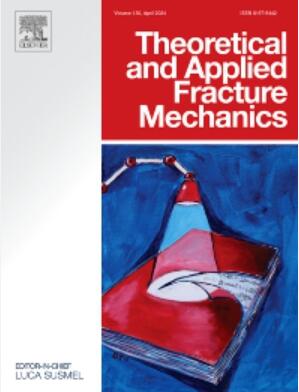Experimental investigation and numerical simulation analysis of non-penetrating spatial crack propagation and coalescence behaviors
IF 5.6
2区 工程技术
Q1 ENGINEERING, MECHANICAL
引用次数: 0
Abstract
This study employs a comprehensive approach integrating experimental analysis and numerical simulation to systematically examine the propagation characteristics of non-penetrating spatial cracks during rock fracturing processes. The results reveal significant differences between the propagation modes of non-penetrating and penetrating cracks. Surface observations demonstrate that anti-wing cracks, as a typical three-dimensional propagation feature, although not necessarily initiating from pre-existing crack tips, predominantly propagate along the loading direction and frequently coalesce with wing cracks to induce localized surface spalling. Internal analysis indicates that crack inclination angle critically influences adjacent crack paths: when the angle between cracks and loading direction increases, micro-cracks preferentially nucleate at edge regions, which subsequently affects both crack propagation behavior and specimen strength. The wrapping effect of wing cracks governs the internal-external connection sequence of adjacent cracks, creating discontinuous propagation patterns through self-inhibition mechanisms until crack coalescence occurs. Peak strength analysis shows a non-monotonic relationship with inclination angles, exhibiting fluctuations at 15° and 45° before reaching maximum values at 90°. Notably, wrapping phenomena persist universally across specimens (including surface-cracked specimens) except at 0° and 90° inclinations, confirming their prevalence in rock fracture processes. Under these special inclination conditions, newly formed cracks exhibit distinct directional propagation characteristics. These findings elucidate the three-dimensional evolution mechanisms of non-penetrating spatial cracks and establish a theoretical foundation for fracture prediction in rock engineering.
非穿透性空间裂纹扩展与聚并行为的实验研究与数值模拟分析
本研究采用实验分析与数值模拟相结合的综合方法,系统研究了岩石破裂过程中非穿透性空间裂缝的扩展特征。结果表明,非穿透性裂纹和穿透性裂纹的扩展模式存在显著差异。表面观察表明,反翼裂纹作为一种典型的三维扩展特征,虽然不一定是从预先存在的裂纹尖端开始,但主要沿着加载方向扩展,并经常与机翼裂纹合并,导致局部表面剥落。内部分析表明,裂纹倾角对相邻裂纹路径影响较大,当裂纹与加载方向夹角增大时,微裂纹优先在边缘区域形核,进而影响裂纹扩展行为和试样强度。机翼裂纹的包裹效应支配着相邻裂纹的内外连接顺序,通过自抑制机制形成不连续的扩展模式,直至裂纹合并。峰值强度分析与倾角呈非单调关系,在倾角为15°和45°时出现波动,在倾角为90°时达到最大值。值得注意的是,除了0°和90°倾角外,包裹现象普遍存在于试样(包括表面裂纹试样)中,证实了它们在岩石破裂过程中的普遍性。在这些特殊的倾斜条件下,新形成的裂纹表现出明显的定向扩展特征。研究结果阐明了非穿透性空间裂缝的三维演化机制,为岩石工程裂缝预测奠定了理论基础。
本文章由计算机程序翻译,如有差异,请以英文原文为准。
求助全文
约1分钟内获得全文
求助全文
来源期刊

Theoretical and Applied Fracture Mechanics
工程技术-工程:机械
CiteScore
8.40
自引率
18.90%
发文量
435
审稿时长
37 days
期刊介绍:
Theoretical and Applied Fracture Mechanics'' aims & scopes have been re-designed to cover both the theoretical, applied, and numerical aspects associated with those cracking related phenomena taking place, at a micro-, meso-, and macroscopic level, in materials/components/structures of any kind.
The journal aims to cover the cracking/mechanical behaviour of materials/components/structures in those situations involving both time-independent and time-dependent system of external forces/moments (such as, for instance, quasi-static, impulsive, impact, blasting, creep, contact, and fatigue loading). Since, under the above circumstances, the mechanical behaviour of cracked materials/components/structures is also affected by the environmental conditions, the journal would consider also those theoretical/experimental research works investigating the effect of external variables such as, for instance, the effect of corrosive environments as well as of high/low-temperature.
 求助内容:
求助内容: 应助结果提醒方式:
应助结果提醒方式:


